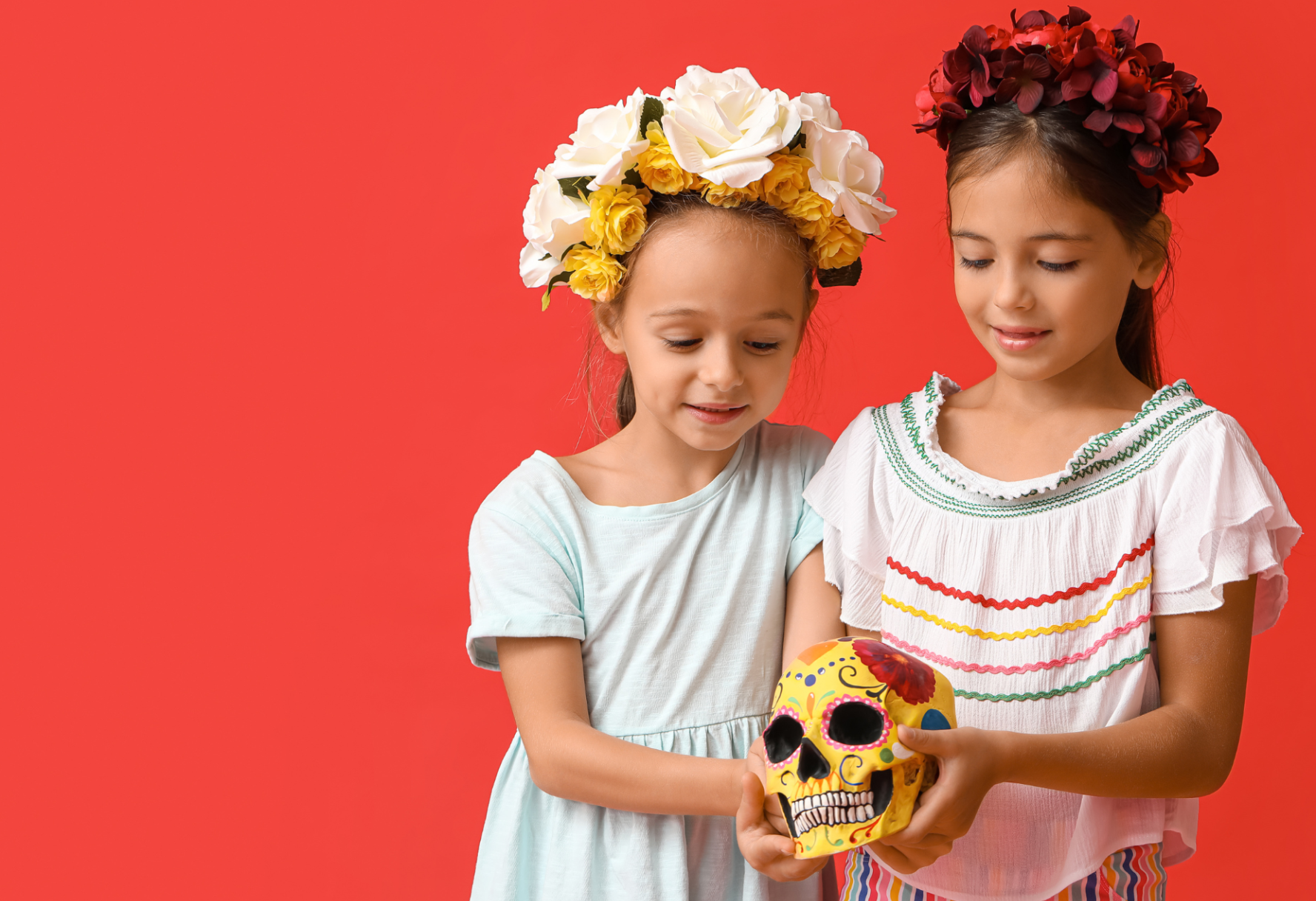Mami, are we going to die? My 4 year old asked during our afternoon walk yesterday. My kids talk a lot about death and dying, so I didn’t pay much attention to his question. I offered some reassurance and we moved on.
Then this morning, he again asked, “Mami, are we going to die on Halloween?”
The additional information about him thinking about death and dying around this holiday made me pause and show up with curiosity. “No, sweetheart, but I’m wondering where this fear is coming from? Are you learning about Halloween and Día de los Muertos at school?” He said yes, so we had an opportunity to delve deeper into the conversation.
Young children, generally under seven years of age, are still developing their understanding and differentiation of their inner magical world and their external reality. This thinking process is sometimes referred to as magical thinking. It is important for parents, caregivers and educators to be aware of this important milestone in childhood. The concepts of death and dying are deeply intertwined with culture and spirituality, so a one-size-fits-all approach is not always best when discussing these topics at school. When discussing death and dying with young children, it is important to follow up with space for reflection and plenty of space for questions. Adults can also invite children to share their own understanding and experiences with death and dying. Repetition can help young children process new information, so you may find yourself responding to the same question over and over again.
Before embarking on these discussions, adults must reflect on their own understanding, experiences and approaches to death and dying. This helps us be prepared to calmly hold space for kids to ask questions. Death is an inevitable part of life, and as parents, discussing this topic with our children can be challenging. Día de los Muertos, typically a two day Mexican holiday celebrated in the beginning of November with Día de los Santos celebrated on the 1st and Día de los Muertos on November 2nd, provides an excellent opportunity to broach the subject of death and dying with our kids in a developmentally appropriate way. This unique celebration not only allows for conversations about the concept of mortality but also fosters rituals that promote healing space for grief in a way that is both comforting and empowering for children.
Rituals offer an opportunity to actively participate in the process of grief, which is often left to the individual to process silently. One of the beautiful aspects of Día de los Muertos is its focus on rituals that allow people to remember and celebrate the lives of their loved ones who have passed away. Creating an altar that includes flowers, candles and some items that help the family remember our loved ones who have died offer a physical connection to the grief process. Children can participate in making papel picado, cooking or purchasing food items to include in the altar and praying, singing or simply acknowledging the presence of the altar and what it symbolizes.
These activities can help kids connect with the idea that death and dying is not all scary and sad, and that we can celebrate a person's life rather even after they have died. In this way, Día de los Muertos can teach children that it's okay to remember and honor their loved ones, even if they are no longer with us.
Día de los Muertos is an opportunity to create lasting memories with our children. It allows us to create space to share stories and fond memories of the departed loved ones, ask questions to learn more about our loved ones or about death, connect emotionally as a family and participate in celebratory rituals together. Engaging in these conversations can help your children understand that while the body may no longer be here, the love and memories remain.
By fostering open dialogue and engaging in meaningful rituals, we can help our children navigate the complex topic of mortality with sensitivity and understanding. Remember that the key is to approach these discussions with empathy and patience, allowing children to ask questions and helping them process their emotions.
Then this morning, he again asked, “Mami, are we going to die on Halloween?”
The additional information about him thinking about death and dying around this holiday made me pause and show up with curiosity. “No, sweetheart, but I’m wondering where this fear is coming from? Are you learning about Halloween and Día de los Muertos at school?” He said yes, so we had an opportunity to delve deeper into the conversation.
Young children, generally under seven years of age, are still developing their understanding and differentiation of their inner magical world and their external reality. This thinking process is sometimes referred to as magical thinking. It is important for parents, caregivers and educators to be aware of this important milestone in childhood. The concepts of death and dying are deeply intertwined with culture and spirituality, so a one-size-fits-all approach is not always best when discussing these topics at school. When discussing death and dying with young children, it is important to follow up with space for reflection and plenty of space for questions. Adults can also invite children to share their own understanding and experiences with death and dying. Repetition can help young children process new information, so you may find yourself responding to the same question over and over again.
Before embarking on these discussions, adults must reflect on their own understanding, experiences and approaches to death and dying. This helps us be prepared to calmly hold space for kids to ask questions. Death is an inevitable part of life, and as parents, discussing this topic with our children can be challenging. Día de los Muertos, typically a two day Mexican holiday celebrated in the beginning of November with Día de los Santos celebrated on the 1st and Día de los Muertos on November 2nd, provides an excellent opportunity to broach the subject of death and dying with our kids in a developmentally appropriate way. This unique celebration not only allows for conversations about the concept of mortality but also fosters rituals that promote healing space for grief in a way that is both comforting and empowering for children.
Rituals offer an opportunity to actively participate in the process of grief, which is often left to the individual to process silently. One of the beautiful aspects of Día de los Muertos is its focus on rituals that allow people to remember and celebrate the lives of their loved ones who have passed away. Creating an altar that includes flowers, candles and some items that help the family remember our loved ones who have died offer a physical connection to the grief process. Children can participate in making papel picado, cooking or purchasing food items to include in the altar and praying, singing or simply acknowledging the presence of the altar and what it symbolizes.
These activities can help kids connect with the idea that death and dying is not all scary and sad, and that we can celebrate a person's life rather even after they have died. In this way, Día de los Muertos can teach children that it's okay to remember and honor their loved ones, even if they are no longer with us.
Día de los Muertos is an opportunity to create lasting memories with our children. It allows us to create space to share stories and fond memories of the departed loved ones, ask questions to learn more about our loved ones or about death, connect emotionally as a family and participate in celebratory rituals together. Engaging in these conversations can help your children understand that while the body may no longer be here, the love and memories remain.
By fostering open dialogue and engaging in meaningful rituals, we can help our children navigate the complex topic of mortality with sensitivity and understanding. Remember that the key is to approach these discussions with empathy and patience, allowing children to ask questions and helping them process their emotions.


